Tearing the ACL is one of the most common knee injuries. More than 100,000 ACL tears occur in the U.S. every year.
The ACL helps stabilize the knee when turning or planting the body. Most ACL injuries take place during sports when a person is cutting, pivoting, sidestepping or lands abruptly. Downhill skiing, football, soccer, basketball and gymnastics are some of the sports in which ACL injuries commonly occur. These injuries usually do not involve knee contact and take place at low speed. Often occurs during a non-contact pivoting injury.
This is a ligament you don’t want injured. For starters, it is the one knee ligament that is quite difficult heal on its own, especially high grade partial or complete tears. In addition, it can’t be stitched back together. Women are more likely to suffer an ACL injury than men and ACL injuries are associated with team sports like football, volleyball and soccer.
ACL injuries range from mild, such as a small tear, to severe, such as when the ligament tears completely or when the ligament and part of the bone separate from the rest of the bone. The ACL can be torn in the middle, off the thigh bone (femur) or off the shin bone (tibia). The location of injury can dictate what treatment is best.
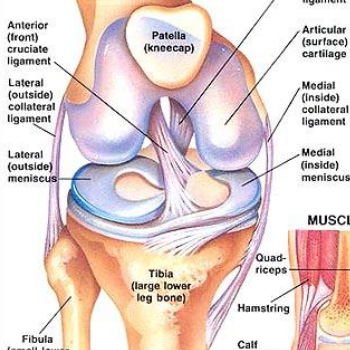
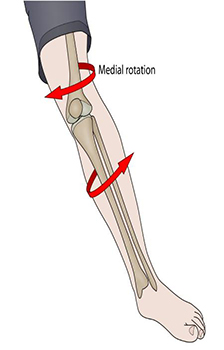
Symptoms of a Torn ACL
Symptoms of an ACL injury can include:
-
Feeling a “pop” inside your knee when the ACL tears
-
Pain with moving the knee
-
Significant knee swelling within a few hours after injury
-
Severe knee pain that prevents you from continuing to participate in your sport (most common in partial tears of the ACL)
-
No knee pain, especially if the ACL has been completely torn and there is no tension across the injured ligament
-
A black and blue discoloration around the knee, due to bleeding from inside the knee joint
-
A feeling that your injured knee will buckle, “give out” or “give way” if you try to stand
If you are experiencing all or some of these symptoms, you should be evaluated by a knee specialist.
Diagnosis of Torn ACL
If you think you may have an ACL injury, you should be examined as soon as possible. In the examination, the doctor will:
-
Ask you to describe how the injury occurred
-
Examine the injured knee and check it for swelling and bruising
-
Check for areas of tenderness and signs of leaking knee joint fluid
-
Check the knee's stability and determine if any other ligaments besides the ACL are involved in the injury
The doctor may order:
-
A test to assess the ACL's stability and strength. These tests include the Lachman test, the pivot-shift test and the anterior drawer test.
-
X-rays to look for any possible fractures or a magnetic resonance imaging (MRI) scan to view the ACL and check the extent of the injury.
How is an anterior cruciate ligament (ACL) injury treated?
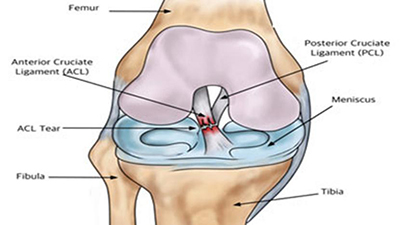
Treatment for an ACL injury includes:
-
First aid right away.
-
Reduce swelling and pain. To do this, you may rest the knee, apply ice, use gentle compression with an elastic bandage, and prop up (elevate) the leg.
-
Move your leg as little as you can.
-
Take over-the-counter pain medicine, such as acetaminophen or nonsteroidal anti-inflammatory drugs (NSAIDs)-ibuprofen, aleve, advil.
-
-
Exercises and training, also called rehab. It takes several months of rehab for your knee to get better.
-
Surgery. You and your surgeon can decide if rehab is enough or if surgery is right for you. If you have surgery, you will also have several months of rehab afterward
You may need to walk with crutches and to keep your knee still for the first few days after the injury.
First of all, it is important that surgeons place the replacement ACL in the exact footprint of the original. This is something that requires an experienced surgeon and is critical to the healing process. It is the only technique that allows the knee to function with its normal internal motion after the completion of the procedure. If the ACL is not reconstructed in the anatomic fashion, then the knee will not move and behave as it did before the injury.
Secondly, it is important that rehabilitation be designed with the intent of enhancing the function of the reconstructed ACL and not just to get the patient up on his or her feet as soon as possible. Once the procedure has been completed, the most important step in achieving an outstanding result is specific and guided physical therapy over the following six to nine months.
ACL Surgery
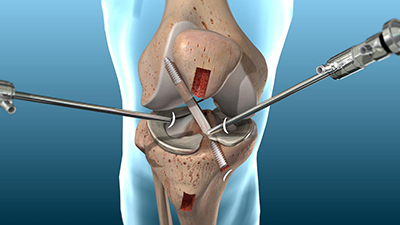
ACL Surgery Recovery
Timeline
Patients usually begin a scheduled program of physical therapy and targeted exercise one to two weeks after ACL surgery. Some physicians may begin rehabilitation as soon as the day after surgery. Rehabilitation after ACL surgery typically takes nine months but may take up to a year.
Physical Therapy
Affiliated physicians and physical therapists meet with patients following surgery to outline the goals of physical therapy, which include restoring function and motion as soon as possible and making sure patients are adequately prepared for the next step. Our physicians and therapists are in constant communication with each other to provide a unique team approach ensuring the highest standard of sports medicine rehabilitation.
Therapists also prepare patients for the mental aspects of ACL recovery, which is particularly important for athletes that will need confidence in their reconstructed knee when returning back to sporting activities.
Physical therapy is an important part of recovery after ACL surgery. Focused exercises restore motion, strengthen the quadriceps and hamstring muscles, and improve joint position awareness that were weakened by the injury. Physical therapy allows active adults and athletes to return to their normal activities and sports safely and helps prevent re-injury.
-
Restoring range of motion is the aim of the first stage of therapy. After six weeks, patients usually can walk without help and perform simple tasks.
-
In the next stage of physical therapy, patients begin exercises to regain flexibility and strength, and balance control.
-
At 12 weeks after surgery, patients usually start a more intense program of exercises with increasing resistance and advanced strengthening techniques that include core strengthening.
-
After 16 weeks, patients may begin activities such as running, depending on associated injuries.
-
Cutting and pivoting activities are usually started around 6 months if rehab is progressing as planned.
-
Regaining quadriceps strength/control is a main limiting factor to returning to sports
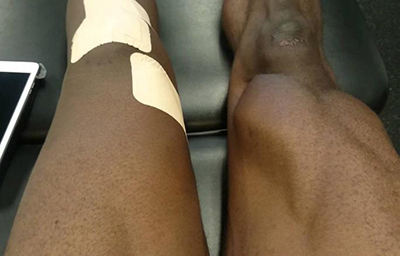
Quad atrophy left Jacked right quad
I hope you find this information beneficial & thank you for trusting me with your care!
Dr. Colten Luedke
Orthopaedic Surgery, Sports Medicine
